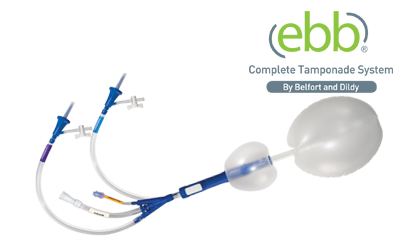ebb
A Complete Tamponade System
Postpartum Hemorrhage is consistently one of the top three causes of maternal mortality and is often the leading cause of maternal death; even in developed countries. Studies suggest that 73-93%⚹ of bleeding deaths are preventable.
Early and proper intervention is key. A rapid-response system is critical. ebb provides a complete tamponade solution to the emergency of postpartum hemorrhage.

The only dual-balloon catheter
The malleable balloon material allows the vaginal balloon to conform to the patient’s anatomy better than silicone. The uterine balloon has a fill capacity of 750 mL, and literature suggests that >500 mL may be required to achieve tamponade in 45%⚹ of cases. The vaginal balloon anchors the uterine balloon, reducing balloon expulsion while potentially treating vaginal bleeding if present.
⚹Download

Enquiry Form

Safety First
With ebb you can monitor continued blood loss through the drain to better understand how much blood the patient has lost. Once drainage stops, check patency by flushing liquid through the irrigation port to check for concealed bleeding within the uterus.

What are the fill volumes for the uterine and vaginal balloons?
The maximum recommended fill volumes are 750ml for the uterine balloon and 300ml for the vaginal balloon. These volumes may be exceeded if clinically necessary.
NOTE: Fill volume ≤ 500ml is usually sufficient for tamponade.1Initial experience with a dual-balloon catheter for the management of postpartum hemorrhage. Dildy GA, Belfort MA, Adair D, et al. Am J Obstet Gynecol. 2014;210:136.e1-6.
How can I confirm proper placement?
Use ultrasound to confirm correct placement within the uterus. When filling, keep fingertips at cervix to ensure the balloon stays in place and is not overfilled. Then a vaginal exam is recommended to ensure that the intrauterine balloon has not been overinflated, which could cause the balloon to prolapse into the vagina.
How long can ebb remain inside the patient?
The timing of this decision is left to the clinician managing the patient. However, efforts should be made to remove or deflate the balloon within 24 hours because of the risk of infection. Ensure adequate staffing before attempting to remove the tamponade balloon in case of adverse reaction.
How quickly should the balloons be deflated?
The catheter should be deflated until it can be atraumatically removed and the area observed for signs of persistent or recurring bleeding. Deflation of the balloon may be achieved by an incremental reduction of fluid volume followed by a period of observation until the uterine balloon is empty. If rapid fluid release is required the inflation lumen may be cut above the spike.
Can ebb be used after C-section?
Of course it can.
What should I use to fill the balloons?
NEVER inflate with air. The balloons can be inflated with an IV bag, ringers lactate solution, distilled water, or any other sort of fluid typically found in the hospital.
Videos
